Session Information
Session Type: Abstract Submissions (ACR)
Background/Purpose: Recent studies highlight the importance of lipid metabolism in the modulation of chondrogenesis. Specifically, the positive chondrogenic effect of acid ceramidase, which is necessary to maintain the metabolic balance of several bioactive lipids, during the chondrogenesis of mesenchymal stem cells (MSCs) has been demonstrated. Therefore, knowledge on the distribution and modulation of lipids during chondrogenesis could be highly valuable to improve MSC-based cartilage therapies by the discovery of new chondrogenic markers. In this work, mass spectrometry imaging (MSI) has been employed to characterize the spatial distribution of lipids in human bone marrow MSCs (hBMSCs) during the first steps of their chondrogenic differentiation.
Methods: hBMSCs micromasses obtained from 3 osteoarthritic donors and collected at day 2 and 14 of chondrogenesis were gelatin-embedded and cryo-sectioned into thin sections for MSI. Samples were then sprayed with matrix and analyzed by matrix-assisted laser desorption ionization (MALDI)-MSI to obtain the lipid profiles. Statistical methods such as PCA and discriminant analysis were used for data interpretation. Lipid images were generated with Biomap software. Data were confirmed by Real-Time PCR analyses.
Results: Analysis of hBMSCs micromasses at days 2 and 14 of chondrogenesis by MALDI-MSI led to the identification of 20 different intact lipid species, including fatty acids, sphingolipids and phospholipids (Table 1). Among the lipid classes identified, we found phosphatidylcholines and sphingomyelins levels decreased during chondrogenic differentiation (Figure 1). These data suggest that hBMSCs mobilize the SMs in order to produce secondary metabolites such as sphingosine-1-phosphate and ceramides that are necessary for their differentiation towards chondrocytes. In addition, a clear up-regulation of 4.74-fold was found for sphingosine kinase 1 (p<0.05) at day 14 when compared to day 2, supporting the low expression of SMs intact species at day 14 of chondrogenesis.
Conclusion: The data compiled herein are undoubtedly useful for a better understanding of the molecular processes that occur during the differentiation of these cells towards cartilage-like tissues. In addition, the differential lipid profiles described in our study might serve as useful differentiation markers for the development of cell-based therapies for cartilage repair. In fact, the loss of SM during chondrogenesis might be used as a novel chondrogenic marker.
Disclosure:
B. Rocha,
None;
B. Cillero-Pastor,
None;
G. Eijkel,
None;
V. Calamia,
None;
L. Lourido,
None;
C. Fernández-Costa,
None;
P. Fernandez-Puente,
None;
J. Mateos,
None;
C. Ruiz-Romero,
None;
R. M. Heeren,
None;
F. J. Blanco Garcia,
None.
« Back to 2014 ACR/ARHP Annual Meeting
ACR Meeting Abstracts - https://acrabstracts.org/abstract/mass-spectrometry-imaging-revealed-potential-lipid-chondrogenic-biomarkers-for-cell-based-therapy-in-cartilage/


